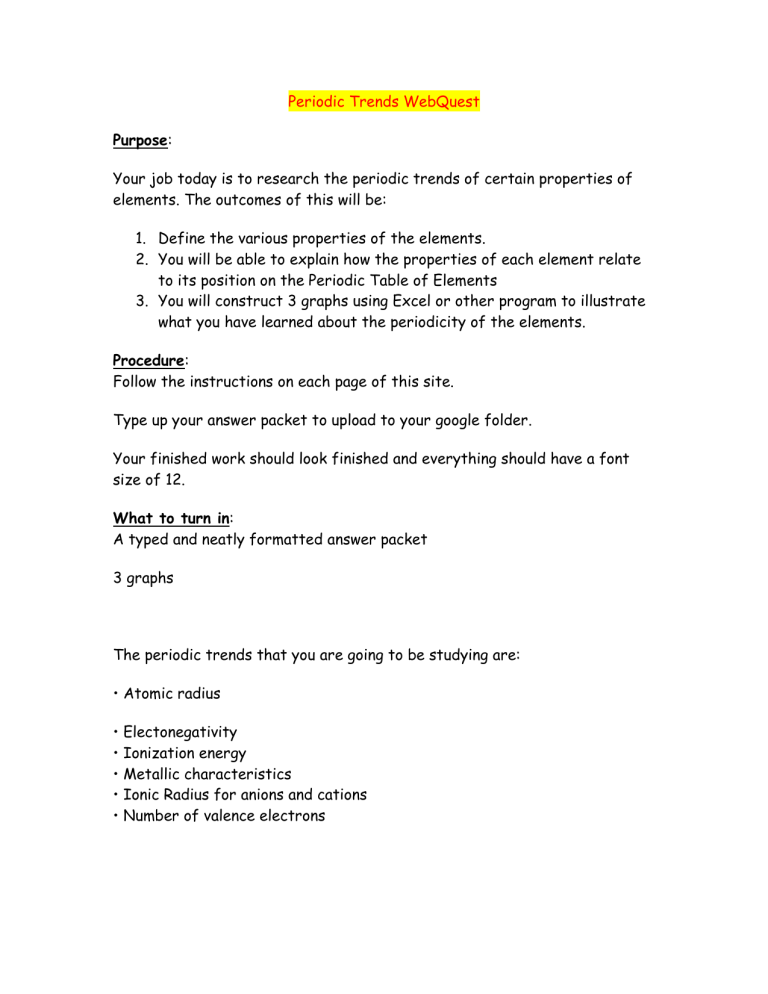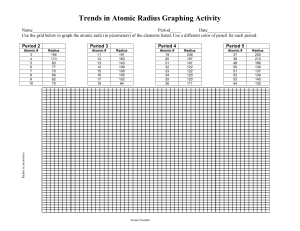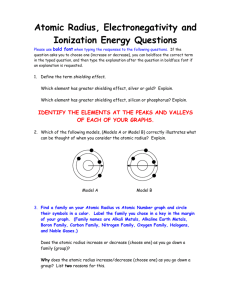Periodic trends webquest

Periodic Trends WebQuest
Purpose:
Your job today is to research the periodic trends of certain properties of elements. The outcomes of this will be:
1.
Define the various properties of the elements.
2.
You will be able to explain how the properties of each element relate to its position on the Periodic Table of Elements
3.
You will construct 3 graphs using Excel or other program to illustrate what you have learned about the periodicity of the elements.
Procedure:
Follow the instructions on each page of this site.
Type up your answer packet to upload to your google folder.
Your finished work should look finished and everything should have a font size of 12.
What to turn in:
A typed and neatly formatted answer packet
3 graphs
The periodic trends that you are going to be studying are:
• Atomic radius
• Electonegativity
• Ionization energy
• Metallic characteristics
• Ionic Radius for anions and cations
• Number of valence electrons
Part I: Definitions
Find definitions for the following terms:
1.
Atomic radius (there are four ways to measure it) a.
Covalent Radius b.
van der Waals Radius c.
Metallic Radius d.
Atomic Radius
2.
Electronegativity
3.
Ionization energy
4.
Metallic characteristics
5.
Ionic Radius
6.
Number of valence electrons
Part II . Use the http://www.ptable.com/#Property/State
Use the data sheets that follow to compile the information from this page.
For each of the first three elements in Periods 2 and 3 , find the Atomic
Radius
1.
What appears to be the trend in atomic radius as you move across a
Period?
2.
What appears to be the trend in atomic radius as you move down a group?
3.
Predict the change in atomic radius of the next elements in a row ( C , Si ), then check those properties. Do they match your predictions?
4.
Check the atomic radius of the next elements in the series ( N , P ). How do they fit the predicted pattern?
5.
Characterize the patterns as either absolute or general and explain your answer.
Repeat the same steps and questions, but look at the property of first ionization energy and then repeat again for electronegativity .
Data sheet for Part II – Atomic Radius
Atomic Radii for several elements
Li Be B
Na Mg Al
4.
3.
Answers to questions about atomic radius.
1.
2.
5.
Data sheet for Part II – First Ionization Energy
First Ionization Energy for several elements
Li
Na
Be
Mg
B
Al
Answers to questions about first ionization energy
1.
2.
3.
4.
5.
Data sheet for Part II –Electronegativity
Electronegativity for several elements
Li Be B
Na Mg Al
Answers to questions about electronegativity.
1.
2.
3.
4.
5.
Part III – Graphing your data (on EXCEL)
X axis is already numbered for you on the left of the spreadsheet. Fill in the corresponding value in to the cells next to the numbers. An example will be shown. Then go to insert
You will be turning in your three graphs when you finish
In this portion of the activity you are going to graph the relationship between three atomic properties and the atomic numbers of the first 56
elements.
You will be making graphs for first ionization energy, electronegativity, and atomic radius.
Make appropriate graphs for these properties, one for each. Be sure that each graph includes a title, labeled axes, and units of measurement when appropriate.
The data for each property can be easily found in your Reference
Tables.
All of the data needs to be represented using graphs that you make using a computer.
There are two things that need to be written by hand in Word or on notability on each of the three graphs:
1.
The symbol of each element should be written in next to the point plotted on the graph.
2.
Brackets should be drawn on the graphs to indicate which elements belong to the same periods of the Periodic Table.
Part IV – An assortment of questions
1) Explain the relationship between x and y variables on your graphs.
2) Explain what happens to the size of an atom when it becomes an anion.
3) Explain what happens to the size of an atom when it becomes a cation.
4) Where do you think you would find the most metallic elements of the
Periodic Table? Why?
5) How is the group number related to the number of valence electrons?
6) Identify the group number for each of the following:
1. Alkali metals:
2. Alkaline Earth Metals
3. Halogens
4. Noble Gases
7) Identify the 7 metalloids.







